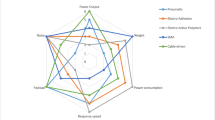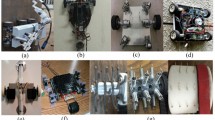Abstract
Many disaster response robots have been studied and developed to reduce the risk of secondary disaster. These robots are expected to improve efficiency and safety. In this paper, we consider a task that a dual-arm disaster response robot pulls a bar whose length and mass are unknown out of a wall as debris removal. Safe working is important in the disaster site to remove debris. Therefore, our objective is to develop a stable pulling out motion. To achieve pulling a target bar out stably, we need to know the physical parameter of the bar. Therefore, the robot uses force/torque sensors attached to the wrists of the robot to estimate the mass and center of gravity position of the bar. Then, the robot controls the bar attitude with the estimated parameters after the bar is pulled out of the wall. Experimental results for verification show the effectiveness of the proposed motion.












Similar content being viewed by others
References
Ishii A (2006) Operating system of a double-front work machine for simultaneous operation. In: 23rd International symposium on automation and robotics in construction, pp 539–542
Nagatani K, Kiribayashi S, Nishimura T, Hada Y, Okada Y, Tadokoro S, Yoshida T (2011) Redesign of rescue mobile robot quince. In: Proceedings of the 2011 IEEE international symposium on safety, security, and rescue robotics, pp 13–18
Matsuzawa T, Hashimoto K, Sun X, Teramachi T, Kimura S, Sakai N, Yoshida Y, Imai A, Kumagai K, Matsubara T, Yamaguchi K, Tan W, Takanishi A (2017) Crawling gait generation method for four-limbed robot based on normalized energy stability margin. In: Proceedings of the 15th IEEE international symposium on safety, security, and rescue robotics 2017, pp 223–229
World Robot Summit. http://worldrobotsummit.org. Accessed 21 Mar 2018
Wu W, Hirogaki H, Aoyama E (2012) Investigation and improving method of two axes synchronous accuracy of plate pivot control with a dual arm robot by estimating ball rolling motion on the plate (in Japanese). Trans Jpn Soc Mech Eng 78(785):292–304
Harada K, Foissotte T, Tsuji T, Nagata K, Yamanobe N, Nakamura A, Kawai Y (2012) Pick and place planning for dual-arm manipulators. In: IEEE international conference on robotics and automation, pp 2281–2286
Liu J, Kamiya Y, Seki H, Hikizu M (2010) Weightlifting motion generation for a stance robot with repeatedly direct kinematics. Intell Control Autom 1(1):20–27
Scokaert POM, Scokaert JM, Rawlings B (1998) Constrained linear quadratic regulation. IEEE Trans Autom Control 43(8):1163–1169
Zhengxiong L, Panfeng H, Zhenyu L (2016) Recursive differenctial evolution algorithm for inertia parameter identification of space manipulator. Int J Adv Robot Syst 13(3):104–118
Tianjun Z, Fundong Z, Jianying L, Fei L, Changfu Z (2018) Development identification method of inertia properties for heavy truck engine based on MIMS test rig. MATEC Web Conf 153:4009–4013
Author information
Authors and Affiliations
Corresponding author
Additional information
This work was presented in part at the 23rd International Symposium on Artificial Life and Robotics, Beppu, Oita, January 18–20, 2018.
About this article
Cite this article
Abe, F., Nakamura, K. & Keitaro, N. Stable pulling out motion for a dual-arm robot. Artif Life Robotics 24, 203–211 (2019). https://doi.org/10.1007/s10015-018-0488-0
Received:
Accepted:
Published:
Issue Date:
DOI: https://doi.org/10.1007/s10015-018-0488-0




